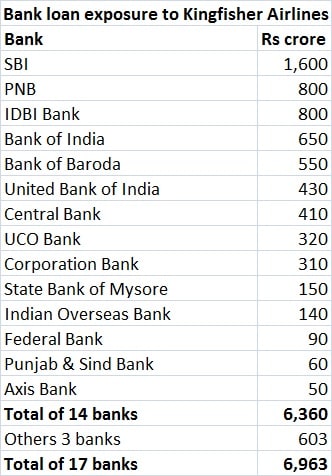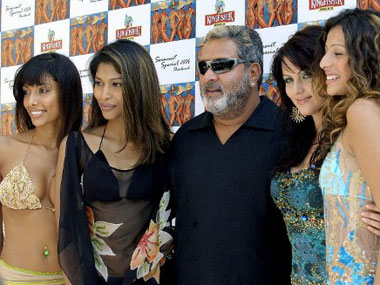The flamboyant liquor baron, Vijay Mallya, once hailed as the King of Good Times and Indian version of Richard Branson, is being chased by almost every institution in the country — the banks, regulators and, finally, the judiciary — for the Rs 9,000 crores he owes to the lenders. How did Mallya fall to his current plight, where he is personally held accountable for the failure of the airline business Kingfisher Airlines and delayed repayment of loans? The answer lies in a decision forced on him by lenders in 2010 to give a second lease of life to the airline that was then on the brink of a collapse. [caption id=“attachment_2667128” align=“alignleft” width=“380”]  Vijay Mallya with models[/caption] “Mallya had his back against the wall. Banks insisted him to offer personal guarantees for any further lending,” said a retired banker, who was previously with State Bank of India (SBI), on condition of anonymity. “Otherwise, there was no reason why Mallya is personally held responsible for the repayment of the loan (Rs 9,000 crore now including the accrued interest amount). There are bigger stressed borrowers (companies) around,” the banker said, giving examples like Bhushan Steel and Winsome Diamonds. The Kingfisher Airline, grounded in 2012, never made profit in its eight years of operations. When Mallya approached the group of lenders for further lending in 2010, there was serious differences of opinion among the group of senior bankers in SBI, and other banks in the consortium, on why should they lend to the airline again. But, the majority decision was to take the big risk again and lend to Mallya. “It was, in a way, throwing good money after bad (since the KFA exposure was already stressed),” the banker quoted earlier said. “But, if we didn’t do that at that point, the exposure till then would have gone bad instantly. No one wanted that to happen. There was no option before us,” said the official. But, everyone knew what was in the store, though no one said anything in the discussion room. “The mood was partly that of helplessness and partly optimism,” the banker said. Bankers were optimistic because Mallya himself was hopeful of turning around the airline, even though the entire aviation industry was groping in darkness. Ironically, however, despite Mallya’s optimism, everyone saw the writing on the wall. Mounting losses In March 2012, Kingsiher halted its international operations to Europe and Asian countries and cut down local flights to 110-125 a day with a fleet of 20 planes from 340 flights earlier to save money. By October 2012, the bird flapped its wings for the last time. Since then, it hasn’t seen the skies. Kingfisher, once the second-largest airline in India, had little chances of resuming its operations since the necessary regulatory approvals were not in sight and its balance sheet was bleeding. The company’s losses had widened to Rs 2,142 crore for its fiscal fourth quarter ending in March 2013, compared with a net loss of Rs 1,150 crores a year earlier. The accumulated losses as of March 2013 stood at a whopping Rs 16,023 crore. Its dues had mounted to over Rs 15,000 –Rs 16,000 crore to banks, airports and others and its flying licences expired at the end of last year. The death bells were begining to ring. In his desperation to revive the airline, Mallya twice submitted revival plans to the aviation regulator, with parent UB Group committing initial funding, but with no luck. In its eight-year life, the airline never made profit even once. Mallya remained optimistic though not to lose the airline’s licence. “We have not submitted an ambitious plan. We have submitted a holding plan," Mallya told reporters, while the government wasn’t convinced. “The problem is in the last two to three months, he’s given so many plans and he’s not adhered to any of them,” the then Aviation Minister Ajit Singh told reporters in New Delhi. Panic grips banks Panic was beginning to set in in the banking industry, especially state-run banks, which were the majority in the banking consortium. After all, banks had to answer a lot to shareholders not just for further lending to Mallya in 2010, but for offering generous loan recast facilities and converting the debt of Kingfisher to equity at a huge premium.  In early 2011, the bank consortium including SBI had converted debt amounting to Rs 1,400 crore into equity at a 60 percent premium to the prevailing market price. Going by the stock exchange data, on March 31, there was preferential allotment to SBI and ICICI Bank due for conversion of compulsorily convertible preference shares into equity shares at a price of Rs 64.48 each. Remember, on that day, KFA shares closed at Rs 39.90 on the BSE. “Within a few months, the share value had eroded so much that banks were put in a difficult position,” said the banker quoted earlier. Kingfisher last traded at Rs 1.36 on the BSE on 22 June 2015. The entire loan restructuring exercise to Kingfisher was done without any special dispensation from the RBI, which means that banks had to make heavy provisioning on their books, hoping that the airline will revive sooner or later and pay back the money. That never happened. Finally, Kingfisher, was declared an NPA by most banks, including SBI, towards the end of 2011 and beginning of 2012. The majority burden of Kingfisher loans was on government-owned banks. The smartest in the lot was ICICI Bank, which managed to sell its entire Rs 430 crore Kingfisher loan exposure to a debt fund managed by the Kolkata-based Srei Infrastructure Finance Ltd in mid-2012. The sarkari banks were the real bakaras in the entire story. So what lies ahead? Banks’ chances of getting their money back from Mallya are very less since Kingfisher hardly has any assets left for banks. Even if banks go ahead and sell Kingfisher assets such as the Kingfisher House in Mumbai, it will fetch only a fraction of what is at stake. The only hope for banks is if Mallya himself have a change of mind and decides to pay back banks from his personal wealth (Mallya has shares worth Rs7000 crore in various companies and lot more in fixed assets). “But, all that will happen if he returns to the country and say he will pay back,” the banker said, adding that bankers are more irked by Mallya flaunting his wealth publicly even now when thousands of crores are at stake. According to reports Mallya already received $40 million of his severance pay from Diageo before he flew to UK. Can the final battle between banks, led by SBI, and Mallya in Supreme Court and Bangalore DRT result in lenders getting their money back. Chances are less. (Kishor Kadam Contributed to this story)
Can the final battle between banks, led by SBI, and Mallya in Supreme Court and Bangalore DRT result in lenders getting their money back. Chances are less
Advertisement
End of Article


)

)
)
)
)
)
)
)
)



